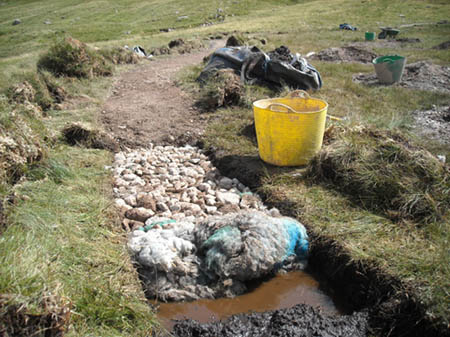Walkers on a Lake District path may feel a little sheepish as they cross a notoriously boggy section.
The route, across Martcrag Moor near Langdale, has been restored using wool fleeces, in work run as part of the Fix the Fells project. The technique will help protect important archaeological relics in the area, north-west of the Langdale Pikes.
The path, across wet bog, had seen a widening erosion scar develop as walkers chose the least treacherous route over the spongy ground. Laying stone and gravel direct on to the bog was not possible – it would simply have sunk. So a team of volunteers working with the National Trust dug a shallow trench which was filled with rolled up fleeces, on top of which was laid stone and gravel. The wool base prevents the stone sinking into the moss.
John Atkinson of Fix the Fells said: “The wool foundations allow the path to effectively float above the deep peat and are being used as a more sustainable alternative to a manufactured geotextile product.
“While the method might seem innovative, it is actually developed from ancient engineering techniques for building routes over waterlogged ground. It was important that we didn’t dig deep in to the peat and disturb the sensitive archaeology, so this was a great solution. The wool came from the Herdwick sheep that graze the fell and we’re really pleased to use a sustainable local resource that will benefit so many people using the path.”
The archaeology includes the remains of ancient axe workshops discovered by chance by a walker earlier this year. The site was photographed and its position recorded using GPS devices, before the path was restored.
National Trust archaeologist Jamie Lund said: “We know that the hard volcanic stone found in areas throughout the central Lake District was used by people to make axes and other tools during the Neolithic.
“Every so often a previously unrecorded stone working site will be exposed from under the peat, often as a result of erosion from water or access. This is what happened on Martcrag Moor earlier in the year when a member of the public noticed spreads of strange-looking stones on the path and contacted the National Trust to see if they were significant.
“When we visited we found around six small working floors where people had stopped to create rough out axes, leaving behind a pile of waste flakes. It is thrilling to think that these stone flakes represent the activity of somebody who lived several thousands of years ago and that they have only now seen the light of day again.”
The volunteer team also built a drain across the top of an erosion scar on nearby Pike of Stickle.
Fix the Fells is supported by the Lake District National Park Authority, the National Trust and the Conservation and Tourism Partnership.
